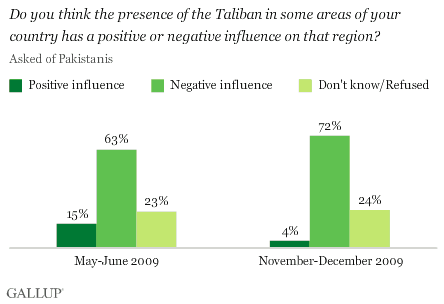
Taliban Increasingly Unpopular in Pakistan
Four percent say Taliban’s presence is positive influence
by Julie Ray and Rajesh Srinivasan, gallup.com, March 12, 2010
This article is the first of a two-part series that looks at Pakistanis’ and Afghans’ views of the Taliban’s influence and their respective countries’ efforts to combat terrorism.
WASHINGTON, D.C. — The Taliban’s presence on either side of the Afghanistan-Pakistan border is largely unwelcome, but increasingly so in Pakistan, where Gallup surveys show they have lost much of the little appeal they had. Four percent of Pakistanis in a November-December 2009 poll, conducted prior to Pakistan’s current push to rout the Taliban within its borders, said the Taliban’s presence in some areas of the country has a positive influence, down from 15% in June.
Gallup most recently polled Pakistanis in the particularly deadly period after the army’s anti-Taliban operations in the South Waziristan tribal area started in October. Retributive militant attacks across Pakistan reportedly have claimed more than 600 Pakistanis’ lives since then, which the public’s increasingly negative view of the Taliban may reflect.
The Taliban lost support in every region of Pakistan. But nowhere are they more unpopular than in the North West Frontier Province (NWFP), ground zero for a full-scale military offensive against the Taliban last May. In November-December 2009, 1% of NWFP residents said the Taliban have a positive influence, down from 11% in June. The percentage saying the Taliban’s influence is positive in Baluchistan, which abuts South Waziristan, dropped from 26% to 5%.
On the other side of the border, Afghans agree with Pakistanis that the Taliban have a negative influence. However, Afghans’ views have remained relatively unchanged despite the Taliban’s threats and violence before the presidential election in August. In both surveys in 2009, roughly 8 in 10 Afghans said the Taliban has a negative influence.
Majorities of Afghans in every region of the country see the Taliban as a negative influence, with their opinions changing little throughout 2009. Residents in the South, which included people in Kandahar, where U.S. and coalition forces are expected to challenge the Taliban this summer, continued to be more likely than others to say the Taliban have a positive influence. But even so, the majority said the Taliban have a negative influence.
Bottom Line
Gallup’s surveys show few Afghans and even fewer Pakistanis view the Taliban’s presence as a positive influence, which suggests there may be popular support for government efforts to dislodge the Taliban. Public support will be an important factor in the coming months if Pakistan continues its anti-Taliban operations and as the U.S. and coalition forces begin their offensive in Kandahar.
For complete data sets or custom research from the more than 150 countries Gallup continually surveys, please contact worldpollpartners@gallup.com or call 202.715.3030.
Survey Methods
Results are based on face-to-face interviews in Pakistan with 1,147 adults, aged 15 and older, conducted in Nov. 14 to Dec. 7, 2009, and 1,133 adults, conducted May 1 to June 30, 2009. For results based on the total sample of national adults, one can say with 95% confidence that the maximum margin of sampling error is ±3.7 percentage points.
FATA/FANA were excluded. The excluded area represents less than 5% of the population. Please note improved sample coverage and change in data collection agency beginning June 2009 measurement. The survey included Azad Jammu and Kashmir, but sample sizes were too small to report results. Maximum margin of error by region in both survey waves ranged from ±6 percentage points in Punjab to ±11 percentage points in Baluchistan.
Results are based on face-to-face interviews with 1,000 adults, aged 15 and older, conducted Sept. 20 to Oct. 12, 2009, and 1,000 adults in June 4-16, 2009, in Afghanistan. For results based on the total sample of national adults, one can say with 95% confidence that the maximum margin of sampling error is ±4 percentage points. Seventeen provinces were randomly chosen from 34 provinces and the sample was adjusted to reflect the population in terms of age, gender, and ethnicity, and rural and urban population. Sample sizes and margins of error for each region were the same in both survey administrations.
North Afghanistan: Results based on interviews with 290 adults from the provinces of Balkh, Kunduz, Sar E Pol, Takhar, Badakhstan, and Samangan. The maximum margin of sampling error is ±7 percentage points.
Central Afghanistan: Results based on interviews with 250 adults from the provinces of Bamiyan, Kabul, Parwan. The maximum margin of sampling error is ±8 percentage points.
South Afghanistan: Results based on interviews with 230 adults from the provinces of Ghazni, Kandahar, Zabul, and Paktika. The maximum margin of sampling error is ±8 percentage points.
West Afghanistan: Results based on interviews with 130 adults from the provinces of Badghis and Herat. The maximum margin of sampling error is ±11 percentage points.
East Afghanistan: Results based on interviews with 100 adults from the provinces of Nurestan and Nangarhar. The maximum margin of sampling error is ±13 percentage points.
The margin of error reflects the influence of data weighting. In addition to sampling error, question wording and practical difficulties in conducting surveys can introduce error or bias into the findings of public opinion polls.